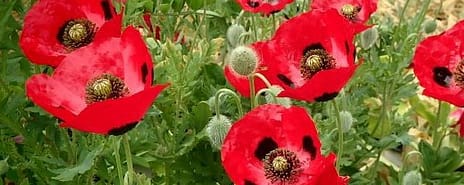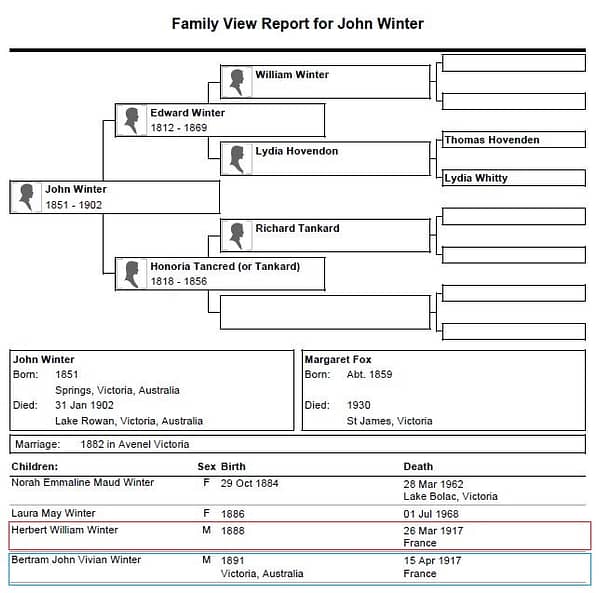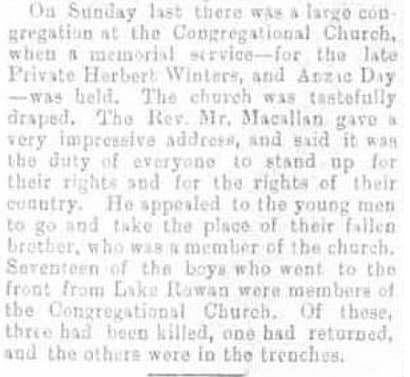Considering that this year’s Anzac Day, 25th April 2018, marked the centenary of the battle to reclaim the village of Villers-Bretonneux in France, I thought it timely to relay the story of Private Bertram John Vivian WINTER, my maternal grandfather’s cousin, who died on the Western Front in 1917 and is commemorated in the Commonwealth War Graves Cemetery at Villers-Bretonneux.
Who was Bertram WINTER?
Bert, as he was known, came from a previously unknown branch of the WINTER family line, that is, until I wrote a blog post a couple of years ago about Bert and his brother, Herb who were both killed on the Western Front in 1917. See ‘Duty Nobly Done’: two Winter brothers KIA in France
Recently, I learnt more about Bert after doing some research for an assignment ‘Biography of a Serviceman/Servicewoman in WW1’ for the unit ‘Families at War’, as part of the Diploma of Family History, University of Tasmania which I’m currently studying. The following are some extracts from the assignment along with some added information. I’ve foregone the footnotes mainly because there were so many! The Bibliography consists of the main sources.

Biography of a First World War Serviceman
Bertram John Vivian WINTER, No. 5111, known as ‘Bert’, enlisted in the Australian Infantry Force (AIF) of World War One at the recruiting branch in Wangaratta, Victoria on 8 March 1916. At the time he was single and 25 years old. He joined 22nd Battalion/13th Reinforcement as a Private.
Family life
Bert was the youngest of four children born to John and Margaret WINTER of Lake Rowan, Victoria. John WINTER was the brother of my great-grandfather William WINTER. John died in 1902 at the age of 51 years when Bert was only eleven years old. The enlistment of the brothers, Herb and Bert, left their widowed mother and their two unmarried sisters to manage the farm.

Lake Rowan is a small agricultural community in north-east Victoria, about halfway between Benalla and Yarrawonga. In 1911, Lake Rowan recorded a population of only 156.
Bert’s reasons for Enlistment
There are no known definitive indicators as to why Bert enlisted, however, there is evidence of a strong feeling of patriotism in his local community and of public shaming. At the memorial service for Bert’s brother Herb, on Anzac Day, 25 April 1917, Reverend Mr. Macallan, of the Congregational Church, Lake Rowan—the WINTER family’s church — ‘appealed to the young men to go and take the place of their fallen brother, who was a member of the church’, adding, ‘it was the duty of everyone to stand up for their rights and for the rights of their country’.

Bert’s exposure to similar appeals may have been the impetus for him to enlist. It’s well documented that patriotism and fear of public shaming were prominent reasons for enlisting at the time. Also, there was talk of bringing in conscription in Australia so Bert may have enlisted out of a sense of inevitability. By January 1916 conscription was already installed in Great Britain. Other reasons for enlisting may have been a sense of adventure, wanting to share the experience with his brother and/or the enticement of regular pay. The latter reason is compelling as there was high unemployment in this part of Victoria at the time. As a point of interest it’s been noted that during the years of WW1 the percentage of the eligible population enlisting was higher in north-eastern Victoria than the national average.
Bert’s send off in Lake Rowan
On 1 May 1916, before heading overseas, Bert was given a send-off /‘a farewell social’, in the Mechanics Hall, Lake Rowan. The night consisted of ‘dancing, interspersed with songs, recitations etc.’ Nine men spoke of the good qualities of Bert and ‘wished him every success and a safe return’. The night concluded with the National Anthem, Auld Lang Syne and For He’s a Jolly Good Fellow.
Training, hospitalization and Bert’s eventual service on the Western Front
After training at Seymour, Bert embarked from Melbourne on 3 July 1916 on the HMATA 33 ‘Ayrshire’ and disembarked 2 months later on 2 September 1916 in Plymouth, England. After another couple of months of further training he sailed on SS Victoria from Folkstone, England to France on 12 November 1916. He marched to Etaples, France and joined his battalion, the 22nd Battalion, on 25 November. He was declared ready for active service on 2nd December 1916. However, the next day he was diagnosed with orchitis (inflammation of the testicle) and admitted to 1st New Zealand Stationary Hospital, Armiens, France. He was transferred to the hospital in Rouen, France with a diagnosis of ‘mumps’. The orchitis being a complication of the mumps. Infectious diseases were common during the war due to the overcrowding and poor sanitation.
After two months hospitalization Bert was deemed fit to return to his battalion. He marched to Etaples again and re-joined the 22nd Battalion on 10 February 1917.
It was now 11 months since Bert enlisted and as far as I can tell from his service record he was yet to see active service. However, this soon changed.
The 22nd Battalion AIF
Prior to Bert joining the battalion for active service, the 22nd Battalion had seen service in Gallipoli, the Somme, Mouquet Farm and Ypres, Belgium. They suffered heavy losses at Pozieres. The Battalion returned to the Somme on 19 October 1916.
The winter of 1916/1917 on the Somme was particularly harsh. There was rain, snow, sleet and frost; ‘fields of frozen mud’. In November 1916 ‘no one cared which horse had won the Melbourne Cup’. ‘The Germans used the time to build a defensive line, the Hindenburg Line’.
Bert was part of the Arras offensive, France, which commenced on 9 April 1917. He was to spend the remainder of his wartime experience and the rest of his life on the Western Front.

Bert’s death and burial on the Western Front
Bert was killed at Bullecourt on 15th April 1917, just over 2 months after rejoining his battalion. According to witness reports gathered by the Australian Red Cross Society Bert was on sentry duty at a listening post in No Man’s Land near Bullecourt on the morning of 15th April 1917. At 6 am a party of 10 Germans rushed the post and Bert was shot in the chest with a revolver. He died instantly.
Below are three witness reports of Bert’s death and burial as gathered and documented by the Australian Red Cross Society. These can be accessed on the Australian War Memorial website:



As reported above Lieutenant Frederick GAWLER (not Gauter), AIF, shot and killed 9 of the Germans. GAWLER was awarded the Military Cross for his gallantry. According to the reports Bert was buried along the railway embankment in Bullecourt. A photo from Australian War Memorial website of the railway embankment shows a ravaged landscape. It’s not surprising Bert’s grave could not be located after the war.

There is no information to say that Bert knew at the time of his death that his brother, Herb, had been killed just 3 weeks earlier on 26 March 1917, also on the Western Front.
News of Bert’s death in Lake Rowan
Bert’s death was not mentioned at the memorial service held for Herb in Lake Rowan as described earlier. Bert had, in fact, died 10 days prior to the service but, I presume, communication difficulties would have delayed the news reaching the community. According to a newspaper report, ‘Mrs Winters’ was informed of Bert’s death on the 3 May 1917, a week after the service and eighteen days after his death.
A local paper, the Benalla Standard, reports:

‘The sad news came as a great shock to the family, as it is only a few weeks since Mrs Winter(s) eldest son (Herbert) was killed in action. Deceased, who was 26 years of age, was a favorite in the district, and general regret was evoked when the news of his death was received. Heartfelt sympathy is extended to Mrs Winter(s) and family in the loss of their only two boys’.
Margaret WINTER placed a death notice for Bert in the Melbourne newspaper, The Argus:

Correspondence between Bert’s mother and the Defence Department
After Bert’s death, Margaret Winter wrote several letters to the Australian Defence Department. Copies of these letters are contained in Bert’s service record.
In August 1917, she wrote asking for her son’s effects. Parcels arrived seven and twelve months after his death. They contained identity discs, wallet, Testament, watch, postcards, mittens and books.
In 1923, she inquired about Bert’s eligibility for medals. She had read in the Argus that ‘there are 66,000 not claimed’. There’s a sense of frustration in her letter:
‘I have already asked about this some months ago, but heard nothing’.
Bert had, in fact, been awarded the British War Medal and Victory Medal on 17 March 1922.
In 1926, nine years after Bert’s death, she made a further inquiry. She wanted to know if Bert’s…
‘burial place had ever been traced. I would be glad to know’.
Despite burial witnesses, she’s informed that…
‘with regret…no report of burial has been received to date…’.
She’s also told that Bert’s name…
‘would be engraved on the Memorial to the missing to be erected at Villers-Bretonneux…’, (France).
Margaret WINTER’s yearning to know where her son’s body was concurs with Damousi’s reflections on the lack of a body to mourn-‘all this, left loved ones in a state of limbo’.
Lake Rowan commemorates those who enlisted
In August 1917, an ‘honor grove’ of trees was planted in Lake Rowan honouring the 23 enlistees: ‘a living monument to the memory of the brave nurses and soldiers who have left home and dear ones to lay down their lives, if need be, for King and Country’.

The names of those killed in WW1 (including the two brothers, H (Herbert) WINTER and B (Bertram WINTER) were inscribed on the Lake Rowan war memorial:
In summary…
The bulk of Bert WINTER’s war service was spent in training, travelling and hospitalization. His experience of active service was brief, only two months. His death on the Western Front was, thankfully, swift but the lack of a body to mourn prolonged the grief for his mother. Bert was a well thought of young man in his hometown of Lake Rowan and the Red Cross witness reports show Bert made friends whilst in service; he was considered a ‘chum’. Bert (and his brother Herb) live on in Lake Rowan through the public display of their carved names on the war memorial. Lest we forget.

Bibliography
AIF Project, UNSW Canberra at the Australian Defence Force Academy
https://www.aif.adfa.edu.au/index.html Accessed 25 March 2018.
Australian Imperial Force Unit Diaries, ‘22nd Infantry Battalion’, April 1917, AWM4 23/39/20, Australian War Memorial.
Australian Red Cross Society Wounded and Missing Enquiry Bureau Files, 1914-18 War 1DRL/0428, Wallet 2, Australian War Memorial.
Bean, C.E.W. The Official History of Australia in the War of 1914-1918, Volume IV: The AIF in France 1917, Angus and Robertson Ltd, 1941
Beaumont, Joan, ‘Australians and the Great War: Battles, the Home Front and Memory’, Teaching History, pp. 20-27, March 2015.
Burness, Peter, ‘The Battles of Bullecourt’, Wartime, Issue 18, pp. 24-29 Australian War Memorial.
Damousi, Joy, Mourning Practices in Jay Winter, ed. The Cambridge History of the First World War, Vol. III: Civil Society, CUP, Cambridge, 2014, pp.359-84.
Fletcher, Anthony, ‘A New Moral Order’, History Today, Vol. 64, Issue 8 (August 2014), pp. 26-33.
Firstworldwar.com: a Multimedia History of World War One, http://firstworldwar.com/index.htm Accessed 25 March 2018.
Following the Twenty-Second: The First World War Through the Eyes of an Australian Infantry Battalion, https://anzac-22nd-battalion.com/. Accessed 25 March 2018.
Gammage, Bill, ‘The Broken Years: Australian Soldiers in the Great War’, Canberra 1974 pp. 4-24 1974.
Gorman, E. ‘“With the Twenty-Second”: a History of the Twenty-Second Battalion’, A.I.F. Imperial War Museum, London. 1919.
International Encyclopedia of the First World War, 1914-1918 online https://encyclopedia.1914-1918-online.net/ww1-timeline/ Accessed 26 March 2018.
Jobson, K. H., ‘First AIF Enlistment Patterns and Reasons for their Variation’, Australian Defence Force Journal, No. 132, pp. 61- 66, September/October 1998.
McQuilton, John, ‘Enlistment for the First World War in Rural Australia: the case of north-eastern Victoria, 1914-1918’, Journal of the Australian War Memorial, Issue 33.
Medical Association for Prevention of War, http://mapw.org.au/about-mapw. Accessed 25 March 2018.
Monument Australia, http://monumentaustralia.org.au/. Accessed 25 March 2018.
Registrar of Births, Deaths and Marriages, Victoria.
Service Records, No. B2455, National Archives of Australia.
Victorian Places, http://www.victorianplaces.com.au/ Accessed 25 March 2018.
Newspapers:
Benalla Standard
The Argus
Tungamah and Lake Rowan Express and St James Gazette


I think there was a lot of pressure for young single men to enlist and also the pay was quite good. It may be that off-farm income was attractive and the farm was not doing so well because of drought or some such. My great grandfather was a doctor at the hospital at Rouen.
Regards
Anne
Thanks for your comment Anne.
Maybe your great grandfather treated Bert! I’d say your great grandfather was a very busy man who would have seen some terrible things.
Cheers, Marg
Interesting story Marg and well reseached. A Winter family story we knew nothing about previously!
I also note you posted it at 1:32am – burning the midnight oil !
Thanks Geoff,
Yes. I suspect there are lots of Winters out there that we don’t know about but I feel the deeper I dig the more they’ll come to the surface.
Love the early hours of the morning. It’s so quiet, unless the possums are having a party in my roof.
Cheers, Marg
Well researched and well written – as usual Marg. It is the words and thoughts of people like Bert’s mother that get to me. Well done again.
Brian C
Thanks Brian,
Yes, I agree. I couldn’t help but feel great sadness for that mother. The witness reports also got to me. Their words made it very real.
Cheers, Marg.
Thanks Margaret, I was unaware of this man and his story – well done!
Thanks Howard,
A sad tale. One of many I’m sure.
Cheers, Marg
Sad, informative and interesting. Thanks Marg.
Thanks Rosemary,
I can’t imagine losing both your sons and within a few weeks of each other. Such a great loss for that family,
Cheers, Marg.
I have included your blog/s in INTERESTING BLOGS in FRIDAY FOSSICKING at
https://thatmomentintime-crissouli.blogspot.com/2018/04/friday-fossicking-27th-april-2018.html
Thank you, Chris
Thanks for including me Chris.
I just did a little fossicking on your site and found the RAF operations records at the National Archives and on downloading them I found the flight details of David LEE- a cousin of my dad’s who I’ve blogged about-who was killed over Germany during the second World War. Great find. So thank you for leading me in the right direction.
Cheers, Marg.
Marg, you’ve made my day.. I love hearing of success stories…I look forward to reading an additional blog re your find.